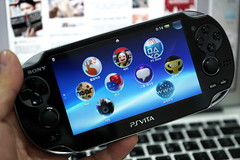 |
| Panasonic LUMIX GX7 via Amazon.com |
Pluses:
*In body image stabilization.
*Super fast focus.
*Wi-Fi (It has NFC for supposedly easy connection. My iPhone won't do that so I can't comment on ease)
*Will focus in very dark conditions. (not quite as quickly but very accurately)
*Good video quality (try the black and white setting at 24 FPS for an old time movie look!)
*Lots of external controls.
*Very good image quality, as good as the EM-5 or GH3.
*Built in EVF and a good one that tilts up.
*Tilting LCD screen.
*Excellent build.
*Excellent hand grip.
*Flash shoe.
*3 User programmable settings on mode dial.
****It just feels good in the hands!!
Minuses:
*Stabilization doesn't work in video mode (unless you have a stabilized lens).
*The strap rings are too low on the side and get in the way of hands, especially the left one.
*No auto ISO in manual mode. (Fuji has it. Sony doesn't.)
*No microphone jack for use in video, though the stereo built in mics are pretty good for casual vids.
*No weatherproofing, though no other rangefinder competitor has it either.
*All the programmable buttons may overwhelm the less experienced.
*Not good for sports shooting, though I don't know anyone who has used a rangefinder style camera for sports anyway.
I listed a number of minuses but don't consider any of them a big deal. Your mileage may vary. Bottom line, this is the camera I've been waiting for and I'm not disappointed in any way.
P.S. A more personal take.
The camera's grip is shaped such that I hold my right elbow closer to my chest than with the squarish grip on my NEX camera, which tends to push my elbow out and up. With a camera this light that's probably not a big deal but may make for a more stable shot.
I'm not particularly impressed with the stabilization. It's a step in the right direction and does help but it is nowhere near as nice as Olympus OM-D, which I've rented. Since I haven't shot it for about 4 years all I can do is guess, but I'd say it's about as effective as a Pentax K20D, which is 3 generations old. It's better than nothing and helps when using an old model Panasonic 20mm. I'm glad to have it. I wouldn't count on it for handholding a long lens. Since I don't have one, again, that's a guess.
The buttons have a nice positive feel and are sufficiently far apart that I can hit the right one without worrying about it. I've been playing with the buttons while watching videos, which is how I normally learn a camera. Since I've only had this for 4 days I don't have the layout worked into muscle memory.
It's the same with the menu system. I have a Nikon D600 and a Sony NEX 6. I'm going to sell the NEX as it does much the same thing as I intend for the GX7. The menus make more sense than Sony's which can require multiple dips into them to change some things like using extended dynamic range. Also, compared to the NEX, I'd say that the Panasonic has better jpegs and a better metering system. That said, there are a lot of potential ways to program the many function buttons and I'm going to be a while getting the camera set up just the way I want.
I also like the GX7s ability to use a phone as a Wi-Fi remote. Sony does that too but requires the purchase of separate apps for different functions. The Sony is also slower when using the phone as a remote. It takes longer to focus and has a shutter lag. I haven't noticed that with the GX7.
I like shooting a small camera with primes and Sony has a lack of focal length equivalents lower than 50mm. There are some Zeiss ones that are good but they are bulky and expensive. The M43 choices are much more extensive and the lenses are much smaller and less costly, so the total package is smaller and lighter and less expensive. I've been shooting mostly with the Panny 20mm, which seems made for this camera. Next up is the Olympus 12mm, but that's expensive and I'll have to save for it.
What more can I say? This camera is fun to shoot. It just feels right in my hands. That's such a subjective point and may be totally different for others. Everything is fast. It turns on fast, focuses fast, allows me to shoot a number of shots in quick succession and doesn't bog down. I don't use the burst mode. I wish the GX7 had a true 100 ISO mode as I sometimes to take longer exposures in daylight. I'll just need a stronger ND filter to to so than I have.
I've printed a couple of photos from the GX7 at 13X19. That's as big as my printer will go. I can't tell any difference at that size between the GX7 and the NEX 6 at ISO 200 or 800. I do prefer the 4x3 format rather than the 3x2 of an APS sensor. It's closer in shape to the 11x14 inch or 16x20 inch frames that are easy to pick up at Michael's or Target.
One thing I didn't mention in the review is how the camera is totally silent when using the electronic shutter. Turn that off and the camera turns off all other sounds. I think of it as stealth mode. Us that with the touch shutter on the view screen and it's possible to take photos and nobody has a clue. I do mostly street or documentary shooting and I love that ability. Even when people know you're photographing them a shutter can be distracting.
Article Source: http://www.amazon.com/review














